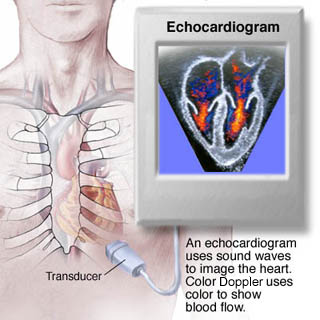During a transesophageal echocardiogram (TEE), a small
transducer attached to a tube (
echoprobe)
is inserted into the esophagus via the mouth and throat. This will not affect
the patientís ability to breathe freely but may temporarily interfere with
swallowing. Once positioned in the esophagus, the transducer can transmit very
clear images of the heartís size, structures and functioning.
A TEE takes up to 90 minutes. Additional time may also be needed for the
physician or technician to record information about the patient and to answer
all of the patientís questions. People who are scheduled for a TEE are
encouraged to arrange for transportation from the test, because they will be
given a calming medication (
sedative) that often leaves them feeling
groggy or light-headed.
Just before the TEE, the patient will be asked to remove dentures and oral
prostheses and to lie down on his or her left side on the examination table.
An intravenous (I.V.) solution is started and a mild calming medication (
sedative)
can be administered. Heart and blood pressure monitoring will begin, and will
continue throughout the procedure. Finally, an anesthetic spray is sprayed
into the throat to reduce the gag reflex.
The physician will insert the echoprobe and feed it to the esophagus, just
behind the heart. The patient may be asked to swallow in order to help move
the echoprobe into location. Some discomfort at this stage is normal. Once in
place, imaging begins. The transducer at the tip of the probe may be
periodically repositioned or advanced.
When imaging is completed, the echoprobe is withdrawn. Monitoring of vital
signs will continue after the procedure until the sedative wears off. At that
time, the patient will be able to leave the hospital or diagnostic center.
People cannot eat or drink anything until the anesthetic spray has worn off
and the gag reflex is restored, or else they could choke. This takes
approximately one hour after the procedure.
Complications are rare, but could include:
- Sore throat or difficulty in swallowing. These are the most common side
effects of the procedure and should resolve within 24 hours.
- Injuries to the mouth or esophagus.
-
Arrhythmias, or irregular heart
rhythms.
People who have additional questions are encouraged to speak with their
physician.
 An electrocardiogram (EKG or ECG) is a recording of the heart's
electrical activity as a graph or series of wave lines on a moving
strip of paper. This gives the physician important information about
the heart. For example, it can show the heartís rate and rhythm. It
can also imply decreased blood flow (cardiac
ischemia), enlargement (hypertrophy)
of the heart or the presence of either current or past
heart attacks.
An electrocardiogram (EKG or ECG) is a recording of the heart's
electrical activity as a graph or series of wave lines on a moving
strip of paper. This gives the physician important information about
the heart. For example, it can show the heartís rate and rhythm. It
can also imply decreased blood flow (cardiac
ischemia), enlargement (hypertrophy)
of the heart or the presence of either current or past
heart attacks. 



 Depending upon the results, further treatment may or
may not be necessary. If damage or a problem is found,
usually a combination of medications and risk-reducing
lifestyle changes is prescribed. Also, additional
tests are usually ordered. Based on the results of the
non-stress EKG, an
Depending upon the results, further treatment may or
may not be necessary. If damage or a problem is found,
usually a combination of medications and risk-reducing
lifestyle changes is prescribed. Also, additional
tests are usually ordered. Based on the results of the
non-stress EKG, an
